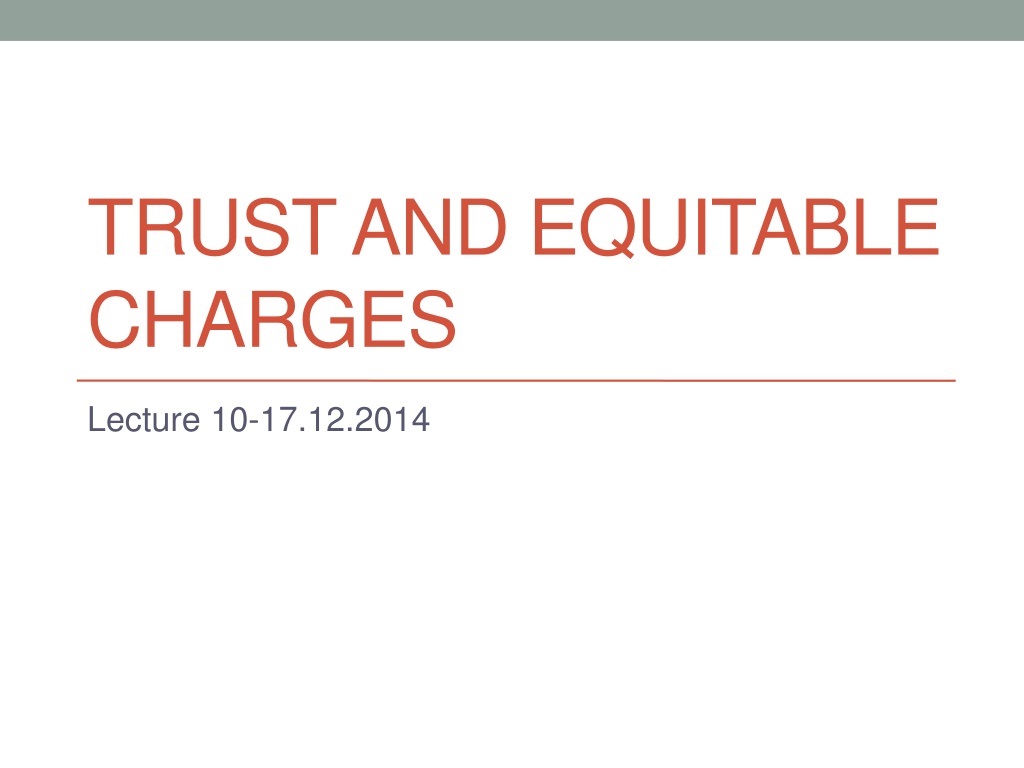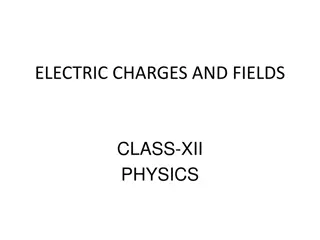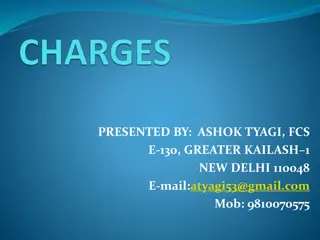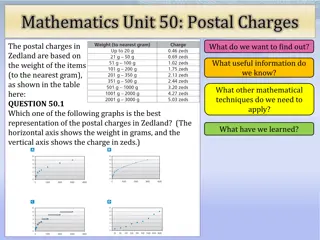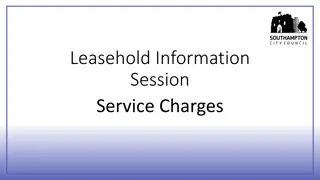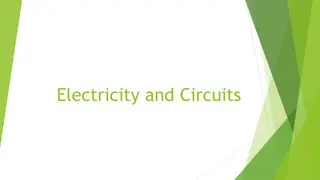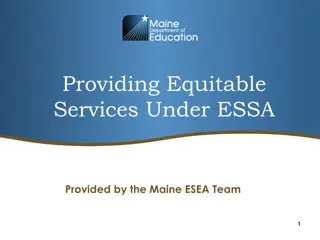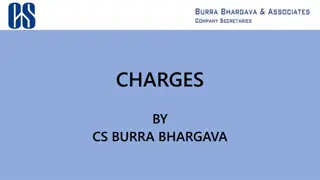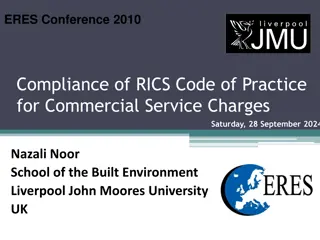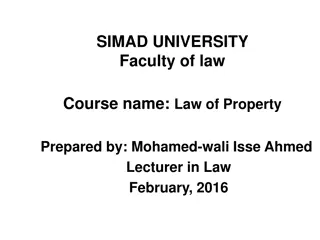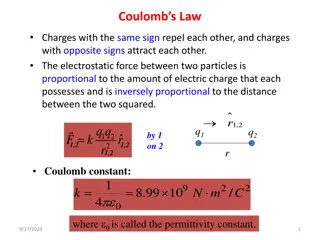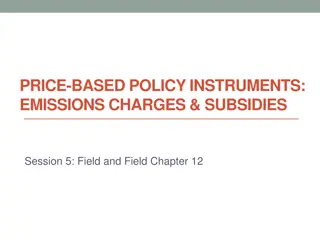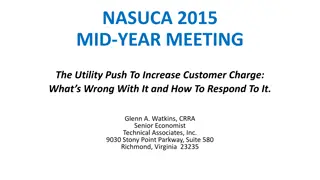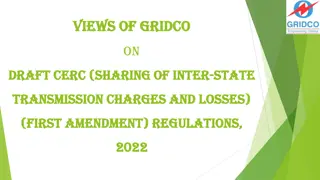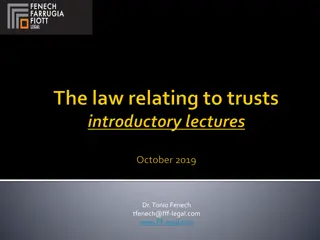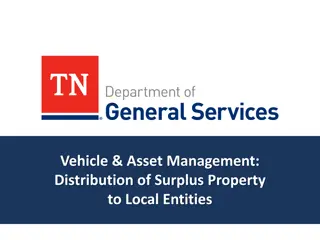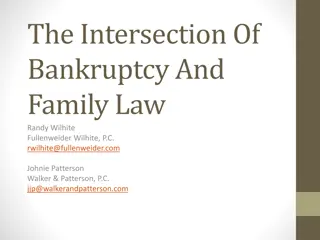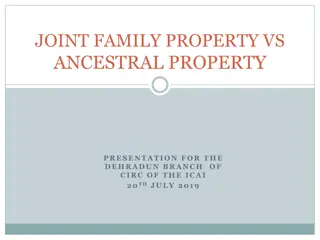Understanding Trust and Equitable Charges in Property Law
Trust and equitable charges in property law involve a legal obligation where the property holder manages the property for the benefit of another person. This trust relationship consists of elements like legal title, trust property, and beneficiaries. The creators of a trust can be referred to as settlors or testators, depending on whether the trust is created during their lifetime or in a will. The key actors in a trust are the creator, trustee, and beneficiary, with the possibility of overlap in roles. Different types of trusts include express trusts, resulting trusts, and constructive trusts, each serving to ensure fairness and proper property ownership.
Download Presentation

Please find below an Image/Link to download the presentation.
The content on the website is provided AS IS for your information and personal use only. It may not be sold, licensed, or shared on other websites without obtaining consent from the author. Download presentation by click this link. If you encounter any issues during the download, it is possible that the publisher has removed the file from their server.
E N D
Presentation Transcript
TRUST AND EQUITABLE CHARGES Lecture 10-17.12.2014
Defintion A trust exists when the titleholder of property is obliged to deal with that property for the benefit of another person
Elements 1. legal title (or a vested equitable title) in the property, subject to fiduciary duties; 2. trust property property in real or personal form which is identified or ascertainable and capable of being held on trust. The trust property can be legal or equitable property; and 3. the beneficiary (sometimes referred to as the cestui que trust in older cases, or the object of the trust in modern cases) a person, or group of persons, who hold a beneficial equitable estate in the property and on whose behalf the trustee must act. the trustee a legal person who holds a vested
Definitions It should be noted that the person who creates the trust during their lifetime is usually referred to as a settlor. Such a trust is often described as an inter vivos trust or a settlement. When the trust has been created in a will, the creator is the author of the will, namely the testator (if male), or testatrix (if female). A trust created in a will is referred to as a post mortem trust. In this and following chapters, the word creator will be used as a collective term to cover both settlors and testators/testatrixs.
Actors in the trust 1. 2. 3. creator; trustee; and beneficiary The three legal actors need not always be different legal persons. It is possible for a creator and a trustee to be the same person, for example, when a trust is created by declaration of trust Similarly it is possible for a creator to be a beneficiary, in cases where the creator instructs the trustee to hold the property for his or her benefit.
Actors in the trust A trustee might also be a beneficiary, but only in situations where the trustee is one of a number of beneficiaries. It is impossible to be the sole trustee and sole beneficiary because once a person owns complete legal and equitable estates they are said to merge together, leaving no distinction between the legal and equitable estates
The three species of trust 1. express trusts; 2. resulting (implied) trusts 3. constructive trusts is an equitable remedy resembling a trust (implied trust) imposed by a court to benefit a party that has been wrongfully deprived of its rights due to either a person obtaining or holding legal right to property which they should not possess due to unjust enrichment or interference
Types of express trusts Fixed Discretionary Bare
Contracts and trusts Gosper v Sawyer (1985) 160 CLR 548 at 568 9; 58 ALR 13 at 26, Mason and Deane JJ stated: The origins and nature of contract and trust are, of course, quite different. There is however no dichotomy between the two. The contractual relationship provides one of the most common bases for the establishment or implication and for the definition of a trust.
Fiduciary relationships and trusts Trusts are a subset of fiduciary relationships and the duties owed by trustees to their beneficiaries are fiduciary in character Fiduciary duties and obligations of trust are not mutually exclusive. A person can owe separate and co-existing fiduciary and trustee obligations
Deceased estates and trusts Executors of deceased estates occupy a similar function to trustees. Executors, like trustees, are fiduciaries. However, an executor s duties exist in relation to the proper administration of the deceased s estate
Bailments and trust A bailment only confers a weak possessory title on the bailee. It does not create a trust as the bailee does not take a vested title in the property
Bailment is distinguished from a contract of sale or a gift of property, as it only involves the transfer of possession and not its ownership. To create a bailment, the bailee must both intend to possess, and actually physically possess, the bailable chattel. Bailment is a typical common law concept although similar concepts exists in civil law (Spain- Dep sito). unlike a lease or rental, the bailee is generally not entitled to the use of the property while it is in his possession.
Agency and trust An agency exists where one person (the principal) authorises another person (the agent) to act as the principal s representative. The actions of an agent bind the principal. Like bailments, agency agreements are based in contract
Debts and trusts The position of creditors is therefore very different from that of beneficiaries. Beneficiaries have equitable interests in the property held by the trustee. Creditors do not have an interest in their creditor s property. A creditor only has access to common law remedies to pursue the debt The institutions of debt and trust can co-exist in the one transaction if there is a common intention that funds will be held for specific purposes eg Quistclose
Debts and trusts Barclays Bank Ltd v Quistclose Investments Ltd [1970] AC 567 Rolls Razor Pty Ltd (Rolls Razor) borrowed a large amount of money from Quistclose Investments Ltd (Quistclose). Quistclose lent the money on the basis that it was to be used for the specific purpose of paying Rolls Razor s shareholders their dividends. Rolls Razor deposited the money in a special account with Barclays Bank. Barclays were informed that the money was only to be used to pay the dividend. Before the dividend was paid Rolls Razor went into liquidation. The bank sought to use the money in the account to set-off the debts which were owed to it by Rolls Razor. Quistclose sought to retrieve the money and claimed that the bank had no right to use the funds in a set-off.
Debts and trusts Lord Wilberforce found that the agreement between Quistclose and Rolls Razor created a primary trust for the shareholders. When that trust could not proceed (due to Rolls Razor s insolvency) the loan became subject to a secondary trust in favour of Quistclose in the event of the money not being used for its dedicated purpose. Finally, given that the bank had notice of the mutual intention of the parties to create a trust, it was bound to respect that trust and could not use the funds to set-off debts owed to it by Rolls Razor.
Debts and trusts The mutual intention of the parties can be discerned from the language employed by the parties, the nature of the transaction and the rele- vant circumstances attending the relationship between them.
Securities and trusts Debts will often be secured. This means that the debtor has agreed to give the creditor a proprietary interest in one or more of his or her assets. Should the debtor not pay, the creditor can realise the security by taking possession of the secured property or by ordering that it be sold and the proceeds be used to satisfy the debt.
Securities and trusts The equitable charge is very similar to a trust. An equitable charge is a form of security that allows the creditor (chargee) to order the sale of the property, after a triggering event, like default of payment. The proceeds of sale can then be used to satisfy amounts due to the chargee
Equitable charge The equitable charge is similar to a trust. An equitable charge is a form of security that allows the creditor (chargee) to order the sale of the property, after a triggering event, like default of payment. The proceeds of sale can then be used to satisfy amounts due to the chargee
Equitable charges An equitable charge is created when property is expressly or constructively made liable, or specially appropriated to the discharge of a debt without there being any intention to transfer ownership of the property. In the event of non- payment of the debt, the creditor s right of realisation is by judicial process i.e. by the appointment of a receiver or an order for sale.
S.53 Law of Property Act 1925 An equitable charge may be in writing (s.53(1)(c) Law of Property Act 1925) ("LPA") but is usually created by deed. Section 53(1) LPA requires a disposition of an equitable interest or trust subsisting at the time of the disposition to be in writing signed by the person making the disposition or by his agent or by will. An equitable charge can be created by express intention and terms.
Kinane v Mackie-Conteh [2004] EWHC 998 (Ch) - s.53 LPA and s.2 LP(MP)A. Mr Kinane lent money to Mr Mackie-Conteh for a trading venture. Mr Kinane alleged that Mr Mackie-Conteh entered into an agreement whereby he agreed to provide security for the loan by way of a legal charge over his home. The facts surrounding this alleged agreement were in dispute, but it was accepted that the agreement did not comply with s.2 LP(MP)A. Mr Kinane tried to enforce his security to recover the debt. He claimed that the agreement created an equitable charge over the property which was enforceable because it complied with s.53 (1)(c) LPA.
Kinane v Mackie-Conteh [2004] Mr Mackie-Conteh claimed that the agreement did not comply with s.53(1)(c); s.53(l)(c) presupposed there to be an existing equitable interest in place capable of being disposed of, which there was not in this case. The court held that the document was sufficient to create an equitable charge and was enforceable because it complied with s.53 LPA. As Fisher and Lightwood, the text book, says "An equitable charge on land or an interest in land must be in writing signed by the chargor or his agent. An instrument which creates an equitable charge and contains an agreement to create a legal mortgage, but fails to comply with the formalities for an equitable mortgage on land, will still create a valid equitable charge."
